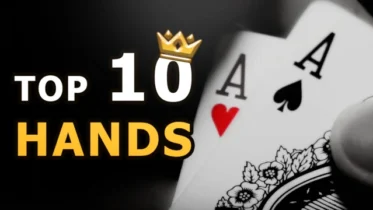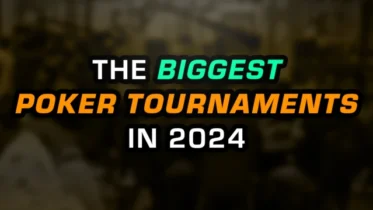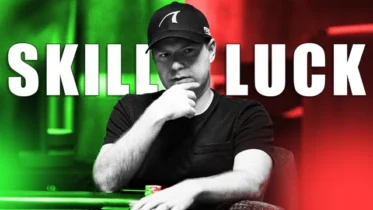As the pre-flop aggressor, one of the natural follow-ups is to continuation bet the flop. The continuation bet is one of the first strategies that we learned coming up in poker during the “Moneymaker Boom”. We were told to follow thru with our story pre-flop and bet every flop. As poker has progressed over the years, we learned that we shouldn’t bet every flop. Across all flops, our continuation bet percentage should be more around the 60% area. Some boards we should continuation bet rarely, as low as 20-30% or sometimes never. However, there are still many boards that we should continuation bet with 100% frequency, or in other words we should “Range Bet”. A range bet is when we raise preflop, and bet every single hand that we raised with on the flop, we bet our entire range. In this article we will discuss why we range bet and what factors allow us to range bet. We will also discuss a few misplayed flop textures that allow us to range bet but are often played to passively.
The Most Important Factor
Range advantage on the flop is the most important factor that allows us to range bet the flop. Let’s look at an A-7-2 rainbow flop. We raise from under the gun (UTG) and the big blind (BB) defends. In this situation, the UTG player has about 66% equity, and the bb has 34% equity. You can plug both ranges into an equity calculator and come up with these numbers. As the UTG raiser, we have a large range advantage for a couple of reasons. First, we have an ace a huge percentage of the time. Second, we have a pair of 8’s thru K’s a large percentage of the time. We have a pair of 8’s, aces, or better 50+% of the time due to our tight opening range. We also have little “air” on this flop. The only air are the suited broadways and strong suited connectors, but those hands still have two overs to the 7 along with backdoor straight and flush draws. The BB on the other end has a ton of air, hands like K-5 suited, Q-T offsuit, K-J offsuit. The BB also has very few strong hands, yes the BB has 7-7 and 2-2, however, the BB should be folding A-7 offsuit against an UTG open.
Are you a bluffing master? Take the quiz to find out!
Equity
On this A-7-2 rainbow board, equity is distributed very polar. Hands either have lots of equity, pairs/ no equity, and under cards to the ace. In contrast, J♥-9♥-7♣ flop has more linear distributed equity. Many hands have at least a 4 card straight draw, an over card or a flush draw. When equities are very polar like the A-7-2 and we have a very large equity advantage, a range bet is the best strategy. We can bet as little as 25% of the pot with every hand and force folds from a large percentage of the BB’s range. The BB simply cannot meet the minimum defense frequency on this flop versus a small range bet. In early position, you can range bet a majority of ace high flops due to the concentration of aces in your range and how wide the BB range is. The BB simply cannot defend enough because he has too many low equity hands.
Using Large Bet Sizes
Let’s look at a different board, the 8-6-2 rainbow flop. Same situation UTG versus BB, this is another board where we want to do a range bet but this time we will range bet with a large sizing of around 70% pot. Same reasons as before, we have a large range advantage of around 60% on this board. The BB should be folding 8-6 offsuit, 6-2 offsuit, 6-2 suited, 8-2 suited to our UTG range (they are making a mistake if they aren’t). While they can have all the sets, and even overpairs as strong as J-J, the BB simply doesn’t have enough strong hands to defend against large bets and barrels. On the A-7-2, we used a small 25-30% sizing but on this flop we want to use a large 70-80% sizing, why the difference? On the 8-6-2 rainbow flop we want to fold out all of his overcards with backdoor flush draws that can easily peel versus the small continuation bet sizing. By betting large, we fold out hands like K-J suited, Q-J suited, K-9 suited etc. We also force lots of money into the pot versus 8x, 6x and 2x hands before over cards come and discourage the BB from putting money into the pot. On this flop, we get to range bet because of the lack of strong hands in the BB’s range and the over pair advantage we have. Also, we get to range bet because on any card T or higher, we make lots of top pairs and get to punish the BB.
In Conclusion
From early position versus a big blind defend, you will have a large equity advantage across a variety of board textures. These positions should lead to the highest continuation bet frequency you will have. In the most basic form, this is your tightest range from UTG versus a very wide BB defend. On disconnected boards with a high card, range bet with a small sizing. On low disconnected boards with no straights possible, use a large sizing for a range bet. Do not exploit yourself by allowing the BB to over realize equity by checking back when you should be range betting. A good practice tool is to generate random flops (or deal them out yourself) and input in a equity calculator with your UTG range and a BB defense range. Learn to see what boards you have a large range advantage on and should range bet, and what boards you range advantage is smaller and you should do more checking.



